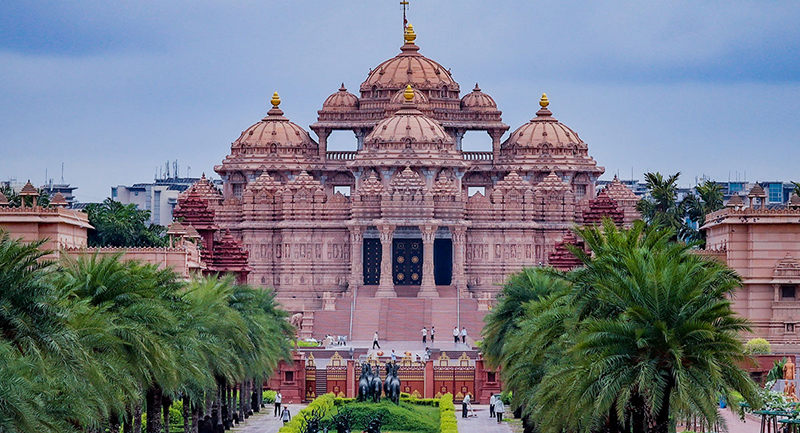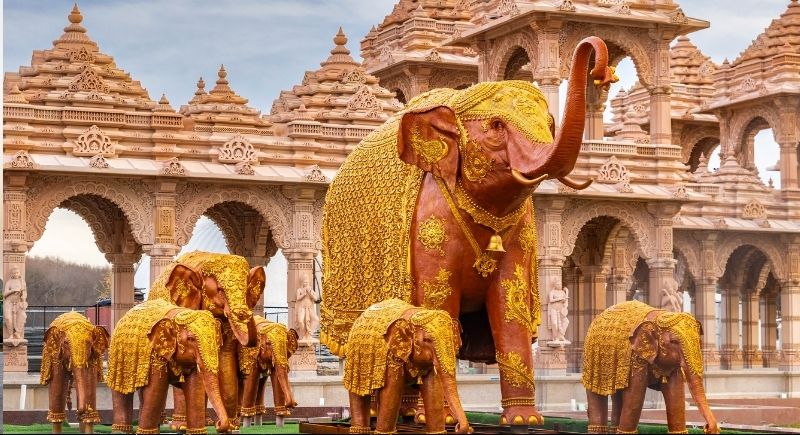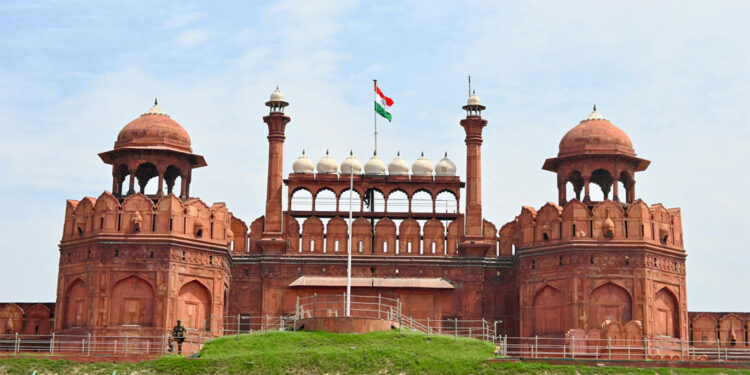In Swaminarayan Hinduism, “Akshardham” signifies the divine abode of the Lord. It represents the serenity and the holiness of the place where devotees worship the holy and seek their blessings. It is considered to be the sacred home of the God on Earth. Swaminarayan Akshardham Delhi is not only a temple; Swaminarayan Akshardham complex is also a cultural and spiritual campus where various activities and exhibitions related to Hindu religion and harmony are organized.
Akshardham Temple’s God is Bhagwan Swaminarayan. Nevertheless, it is also dedicated to revered saints, deities, and avatars of Hindu Gods. The intricately carved Akshardham Mandir accommodates the idols of Bhagwan Swaminarayan and his successors. There are statues of Hindu Gods and Goddesses, such as Lord Krishna and Goddess Radha, Lord Rama and Goddess Sita, Goddess Lakshmi and God Narayana, and Lord Shiva and Devi Parvati.
History of Akshardham Temple Delhi
The Akshardham Mandir Delhi was officially inaugurated for public viewing on November 6, 2005. The late Dr. A.P.J. Abdul Kalam, the president of India, inaugurated it. The Swaminarayan Akshardham complex was built using ancient methods such as Vastu Shastra and Pancharatra Shastra.
Located on the banks of River Yamuna, this temple is close to the 2010 Commonwealth Games village. Yogiji Maharaj conceived the idea of a temple complex around 1968 as the then-spiritual head of BAPS. Later, in 1982, his successor, Pramukh Swami Maharaj, started the work towards constructing the Akshardham complex.
The Delhi Development Authority and the Uttar Pradesh government offered 60 acres and 30 acres of land, respectively, for the project in 2000. In November 2000, the construction of the temple complex started, and it was completed in about five years. It was officially opened in November 2005. The inauguration ceremony was graced by the former Prime Minister of India, Mr. Manmohan Singh, and the opposition leader, Mr. L.K Advani.
Architecture of Akshardham Delhi

Constructed with pink sandstone and marble, Akshardham Mandir is the center of the Swaminarayan Akshardham complex. The vast complex of Swaminarayan Akshardham Delhi comprises the main temple, beautifully laid-out gardens, exhibitions, open courtyards, and water bodies, each section presenting an intriguing aspect of Hindu religion and spirituality.
Akshardham Temple
Gates at Akshardham

The majestic gates are the first thing that greet you at Akshardham Delhi. There are ten gates, which are symbolic of 10 directions. According to Hindu beliefs, these ten gates symbolize accepting good from all directions to nurture the feeling of oneness and peace in the world. Visitors pass through Bhakti Dwar, the Gate of Devotion, to enter Akshardham Delhi. From here, they enter the Visitor Center. There are two Mayur Dwars, also known as Peacock Gates. Between these two Mayur Gates is the ‘Charnarvind.’ It is a massive replica of Bhagwan Swaminarayan’s footprints. Constructed from marble, it features water showers on all four sides. The holy footprints also comprise 16 sacred symbols.
Inside Akshardham Temple, Delhi
Garbhagruh
Mandapams
- The main mandapa inside Akshardham Temple is Swaminarayan Mandapam, the temple’s central sanctum, symbolizing the Lord’s divine abode. At 72 feet high, Paramhansa Mandapam, another mandap, is decorated with exquisitely carved domes and pillars. It has the idols of Paramahansa of Bhagwan Swaminarayan, who was introduced to monkhood by Shri Swaminarayan.
- Thirty-eight feet high is the Ghanshyam Mandapam, built on eight pillars and featuring a vast dome shaped like a saucer. The pillars and ceiling of this mandapa display incidents from Bhagwan Swaminarayan’s childhood. Seventy-two feet high is the Lila Mandapam, which has four-faced pillars carved with the stories of Bhagwan Swaminarayan’s life. It also has an engraved dome.
- Neelkanth Mandapam consists of an idol of Neelkanth Varni adorned with eight-sided pillars and a carved dome. Bhagwan Swaminarayan became known as Neelkanth Varni after he set out on his seven-year pilgrimage. As its name suggests, Smruti Mandapam is where sacred relics like clothes, hair, beads, footprints, and more of Bhagwan Swaminarayan are preserved and displayed for darshan.
- Sahajanand Mandapam is a 32-foot-tall structure with a beautifully carved dome. It houses an idol of Bhagwan Swaminarayan depicted seated under a neem tree. This mandapa’s name denotes the Sahajanand, which was given to Bhagwan Swaminarayan when he was initiated as a sage. Bhakta Mandapam includes 148 statues of devoted followers of Shri Swaminarayan. In Purushottam, Mandapam is a Bhagwan Swaminarayan statue accompanied by his devotee Akshar.


















